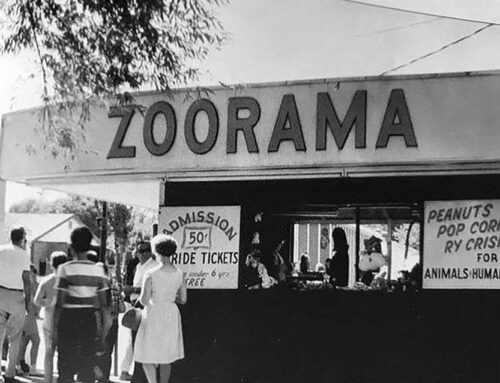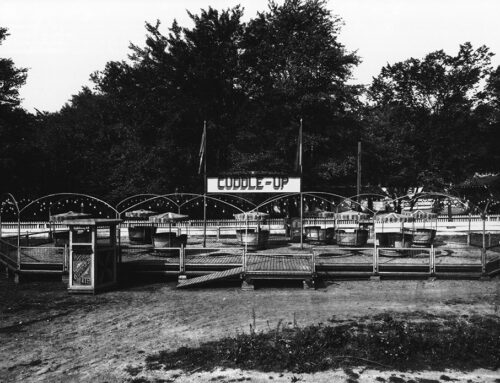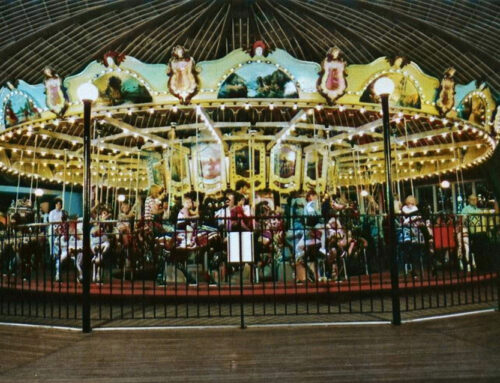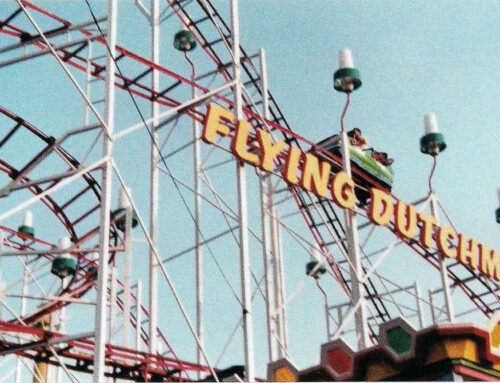In the early 20th century, engineer and inventor Harry G. Traver transformed the amusement industry with his groundbreaking ride, the Circle Swing. Patented in 1902, the ride was said to be inspired by the sight of seagulls circling above a ship during Traver’s transatlantic voyage while he was recovering from illness. Whether this story was fact or folklore, it captured the essence of an invention that offered riders the thrilling illusion of flight. The Circle Swing featured a tall, four-legged steel tower with powerful gearing at its base. At the top, six radial arms rotated horizontally, each one suspending a chain-linked gondola that swung outward as the rotation increased, producing a smooth, soaring sensation.
Below: Harry G. Traver and Circle Swing Design.

The ride became an immediate success. By 1904, Traver had installed dozens of Circle Swings across the United States. Among the earliest and most beloved were the installations at Carsonia Park in Reading, Pennsylvania, and Dorney Park in Allentown, Pennsylvania. Carsonia Park, which opened in 1896, introduced its Circle Swing—locally known as the “High Swing”—in 1904. The ride quickly became a central feature of the park’s lineup. Its refined structure and gentle motion appealed to families, while its elevation offered panoramic views of Carsonia’s lakes, gardens, and midway. The original wicker gondolas were positioned low to the ground for ease of boarding, particularly accommodating guests in the long skirts common to the era.
Below: Traver Circle Swing at Carsonia Park, Reading, Pennsylvania.


By the 1920s, Carsonia’s ride was updated and renamed the “Airplane Ride.” The wicker gondolas were replaced with wooden, canvas-covered airplanes fitted with small electric motors that powered spinning propellers. The redesign reflected the public’s growing fascination with aviation, which had surged in popularity after the Wright brothers’ 1903 flight. This updated version remained a park favorite until Carsonia’s closure in 1950.
Below: Traver Circle Swing at Carsonia Park, Reading, Pennsylvania.



After the park closed, the ride was purchased by Harold Yergey, owner of Twin Grove Park & Campground near Pine Grove in Lebanon County. Yergey transported several of Carsonia’s attractions—including the Airplane Ride, the Pretzel, and the Whiz Bang—to his campground in hopes of recreating the charm of a classic amusement experience. Although the ride’s steel tower was re-erected, mechanical problems with the heavy gear system prevented it from operating. Over time, the wooden airplanes were moved aside and slowly faded into the landscape, though they remained remarkably well-preserved beneath trees and tarps.
In 2008, the ride’s legacy was unexpectedly revived. When Philip Moreau, a new owner from Carmel, California, purchased the Twin Grove property, he discovered seven wooden airplanes from the old ride in a Lebanon warehouse, buried under layers of dust. Recognizing their nostalgic and historical value, he decided to restore the planes for display around the campground. Twin Grove had long served as a weekend escape for working families, offering a pool, penny arcade, and a selection of rides. Moreau aimed to enhance this legacy by showcasing the airplanes as decorative symbols of the park’s heritage.
Before Moreau’s ownership, the previous resort operator had begun reconstructing the ride. A concrete foundation had been poured, and a 75-foot tower erected. Restoration of the planes was underway, and the project had even attracted attention from the National Amusement Park Historical Association. However, state regulators raised numerous safety concerns, ultimately making it too expensive to continue.
With the planes now under his stewardship, Moreau launched a restoration project with the assistance of 18-year-old summer intern Andrew J. McIlvaine from Virginia. McIlvaine delved into the ride’s history and took on the challenge of restoring all seven airplanes. Relying on spare parts and inventive problem-solving, he rebuilt seat cushions, crafted engine replicas from paint cans and copper piping, and fabricated missing components from scratch. His scouting experience and mechanical creativity accelerated the project’s progress, which was completed in 2010.
Below: Restored Traver Circle Swing Airplane.

Today, the restored airplanes are displayed throughout Twin Grove’s 100-acre property, which includes campsites, cabins, a restaurant, an ice cream parlor, a movie theater, and a bandstand. For many longtime residents and returning visitors, the airplanes rekindle memories of childhood summers and simpler times. Some locals recall coming to Twin Grove every weekend, riding those very planes, and watching their families meet, grow, and enjoy life at the campground. The restored airplanes have become beloved emblems of continuity, blending history with present-day enjoyment.
Dorney Park Traver Circle Swing Ride
While Carsonia’s ride lives on through these restorations, the Dorney Park Circle Swing followed a different but equally storied path. Installed in 1906, it operated near where the Scrambler and the entrance to the now-retired “Journey to the Center of the Earth” ride would later stand. Like Carsonia’s, Dorney’s Circle Swing offered a graceful aerial journey with wicker gondolas suspended from chains. The ride became a fixture of the park’s identity for decades.
During the 1930s, amid the economic pressures of the Great Depression, Traver’s company was absorbed by R.E. Chambers Engineering, which began updating his original designs. At Dorney, Chambers retrofitted the Circle Swing into the now-iconic Rocket Ride. The original gondolas were replaced with streamlined rocket-shaped cars that reflected the growing cultural interest in speed, technology, and spaceflight. Though the mechanics of the ride remained similar, the look and feel were dramatically modernized.
Below: Retrofitted Traver Circle Swing Ride at Dorney Park, Allentown, Pennsylvania.


The Rocket Ride remained in operation at Dorney Park until the early 1990s, thrilling guests with its unique blend of nostalgia and motion. As other older attractions disappeared, the Rocket served as a tangible link to the park’s early 20th-century roots. Its eventual removal marked the end of an era, but the memories of its soaring rockets and sweeping motion endured.
Harry Traver’s Circle Swing was more than just a ride—it was an innovation that helped define amusement parks during their golden age. Its evolution from wicker gondolas to wooden airplanes to rocket ships mirrored broader societal shifts, from Victorian elegance to aviation obsession to space-age optimism. Though few of these rides survive today, their impact remains visible at places like Twin Grove Park, where the legacy of Carsonia’s Airplane Ride continues to bring joy and nostalgia to new generations of visitors.







Leave A Comment